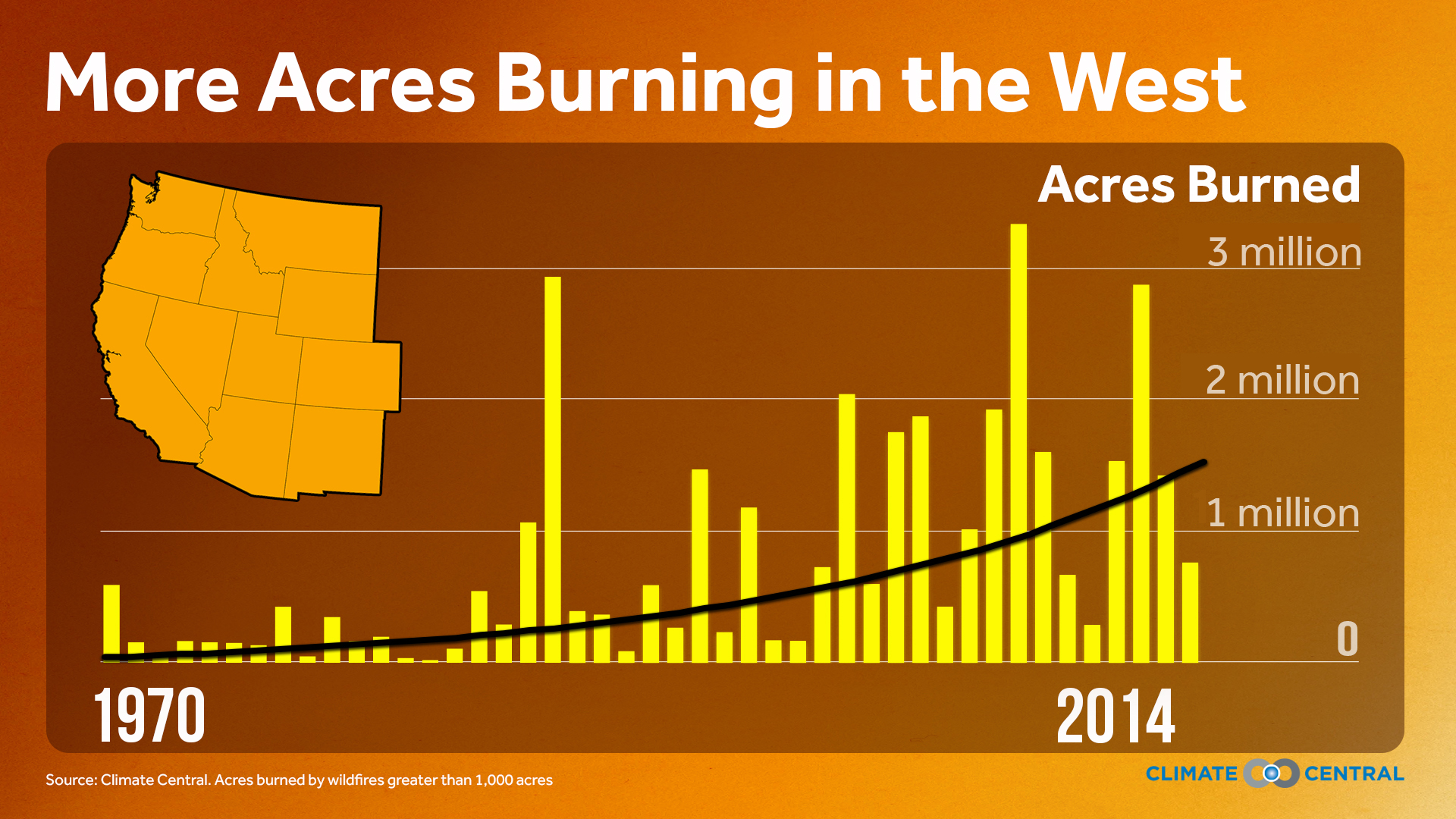Environment & Energy
Related: About this forumFire Season Temps Up 2.1F In American West Since 1970; Fire Season 75 Days Longer
Trends since the 1970s show more large fires and more acres burned by these large wildfires as the West dries out and heats up according to an updated Climate Central analysis. Climate change is one of the key drivers helping set up these dry and hot conditions favorable for wildfires.
Spring and summer — two key seasons for wildfires — have warmed 2.1°F across the West, on average. Some states, particularly those in the Southwest, have warmed even faster. Add in shrinking snowpack that’s also disappearing earlier, and you have a recipe for a wildfire season that’s now 75 days longer and more devastating than it was in the 1970s.

There’s been a notable increase in the large wildfires — defined as those 1,000 acres or bigger. A Climate Central analysis of U.S. Forest Service data through 2014 shows that large fires are three-and-a-half times more common now than they were in the ‘70s. They also burn seven times more acreage in an average year.
The biggest changes are in the Northern Rockies. Large wildfires are now 10 times more common than they used to be and the area burned is up to 45 times greater in Idaho, Montana and Wyoming.


EDIT
http://www.climatecentral.org/gallery/graphics/western-wildfire-trends
shenmue
(38,506 posts)OnlinePoker
(5,716 posts)After that, if it was in the wilderness and didn't threaten anyone or any structures and they were naturally caused, they were allowed to burn. Even today, there is still an awful lot of undergrowth fuel that would have burned in the past if it hadn't been suppressed. Once this sparks, it creates the intense firestorms we've been witnessing lately.
hatrack
(59,574 posts). . . and a fire season now more than two months longer than the 1970 average.
happyslug
(14,779 posts)The Fire Service have three tools they use:
1: The Pulaski, a combination axe and hoe

2. THe McLeod: A combination Rake and How:

3. And "Combination Tool": A model 1943, 1945, 1951 US Army Entrenching tool with s 42 inch handle instead of the 18 inch handle of the Entrenching tools:

https://www.heimanfireequipment.com/product_info.php?manufacturers_id=96&products_id=573&osCsid=middrmceqd5644l9cpnub2b3p6
In 1967 the US Army adopted a new Entrenching tool, the Tri-Fold, sometimes called the M1967 Entrenching tool. The problem with the tri-fold is that you can NOT put a longer handle on it and as such inferior to the Combination tool (and older entrenching tools) when it comes to fight fires.
I have used both the Tri-Fold and the older Bi-fold entrenching tools. When it comes to digging the models 1943, 1945, 1951 entrenching tools (often called "Bi Fold Entrenching tools" for they are made up of two parts that fold together) are better then the Tri-Fold. Now the Tri-Fold fits on a belt better then the Bi-fold and it is a lot easier to ride with one on your belt in an Armor Vehicle or even a Truck then the older Bi-fold but walking I notice no difference.
After WWII the Fire Service received a huge number of 1943 and 1945 bi-folds, and even more in the 1970s as Army Surplus. The Fire Service replaced broken handles with longer handles over time. In the 1990s the US army had finally eliminated all of its pre 1967 entrenching tools and the US Fire Service had to buy them new, thus the 1994 specs for Combination Tool.
I do not believe the Fire Service has any McLeods, Pulaskis or Combination tools NOT being used right now. With the Army no longer having any bi-folds the Army is not in a position to help on the line. THE Army can provide spades and other tools, but all are considered inferior to the above three when it comes to forest fire fighting tools.
Just a comment that sometimes you need to think about what you will do with troops outside the box, and one such use is in support of the fire fighters but to do so the soldiers would need the proper equipment and the tri-old entrenching tool is not a good fire fighting tool.
http://www.fs.fed.us/fire/sdtdc/02511302/02511302.html
hatrack
(59,574 posts)happyslug
(14,779 posts)I use the term "Colored" for that was term in use in the US Army during WWII. It was DENIED use in actual Combat and kept in reserved to fight forest fires.